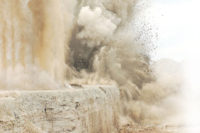On Wednesday, August 7, 2019, a 42-year-old preparation plant electrician with 15 years of mining experience was electrocuted when he contacted an energized connection of a 4,160 VAC electrical circuit. The victim was in the plant’s Motor Control Center (MCC) adjusting the linkage between the disconnect lever and the internal components of the 4,160 VAC panel supplying power to the plant feed belt motors.
Two more mining fatalities by electrocution have occurred since.
- A contract electrician contacted an energized 120 VAC conductor while working inside a fire suppression system’s electrical panel.
- An electrician contacted an exposed energized connector while troubleshooting a 995 VAC flooded bed scrubber motor circuit on board a continuous mining machine.
The electrocution deaths prompted the Mine Safety and Health Administration (MSHA) to issue a safety alert.
Best practices
MSHA’s safety alert lists these best practices to prevent electrical accidents:
- Lockout and tagout the electrical circuit yourself and NEVER rely on others to do this for you.
- Control hazardous energy. Design and arrange MCCs so electrical equipment can be serviced without hazards. Install and maintain a main disconnecting means located at a readily accessible point capable of disconnecting all ungrounded conductors from the circuit to safely service the equipment.
- Install warning labels on line side terminals of circuit breakers and switches indicating the terminal lugs remain energized when the circuit breaker or switch is open.
- Before performing troubleshooting or electrical type work, develop a plan and communicate and discuss the plan with qualified electricians to ensure the task can be completed without creating hazardous situations.
- Follow these steps BEFORE entering an electrical enclosure or performing electrical work:
- Locate the circuit breaker or load break switch away from the enclosure and open it to de-energize the incoming power cable(s) or conductors.
- Locate the visual disconnect away from the enclosure and open it to provide visual evidence that the incoming power cable(s) or conductors have been de-energized.
- Lockout and tagout the visual disconnect.
- Ground the de-energized conductors.
- Wear properly rated and maintained electrical gloves when troubleshooting or testing energized circuits.
- Focus on the task at hand and ensure safe work practices to complete the service. A second qualified electrician should double check to ensure you have followed all necessary safety precautions.
- Use properly rated electrical meters and non-contact voltage testers to ensure electrical circuits have been de-energized.
- Don’t rush. Never work alone. Talk to coworkers and confirm your plan is safe.
- Always troubleshoot without power first.
- If you must troubleshoot an energized circuit, use properly rated personal protective equipment to prevent hazards. For example, use electrically rated gloves, insulated blankets or mats, and polycarbonate barriers to prevent accidental contact with energized components.




